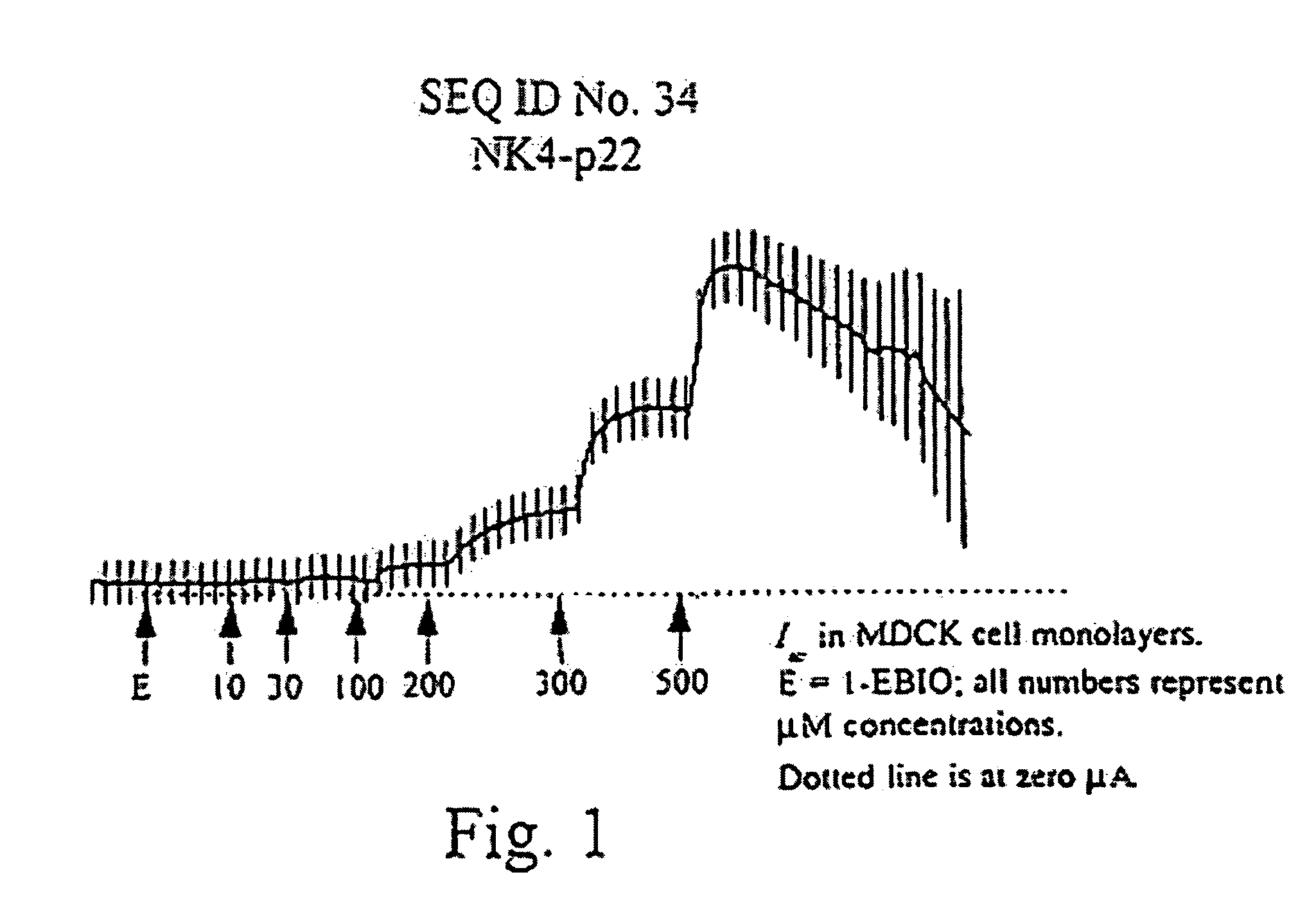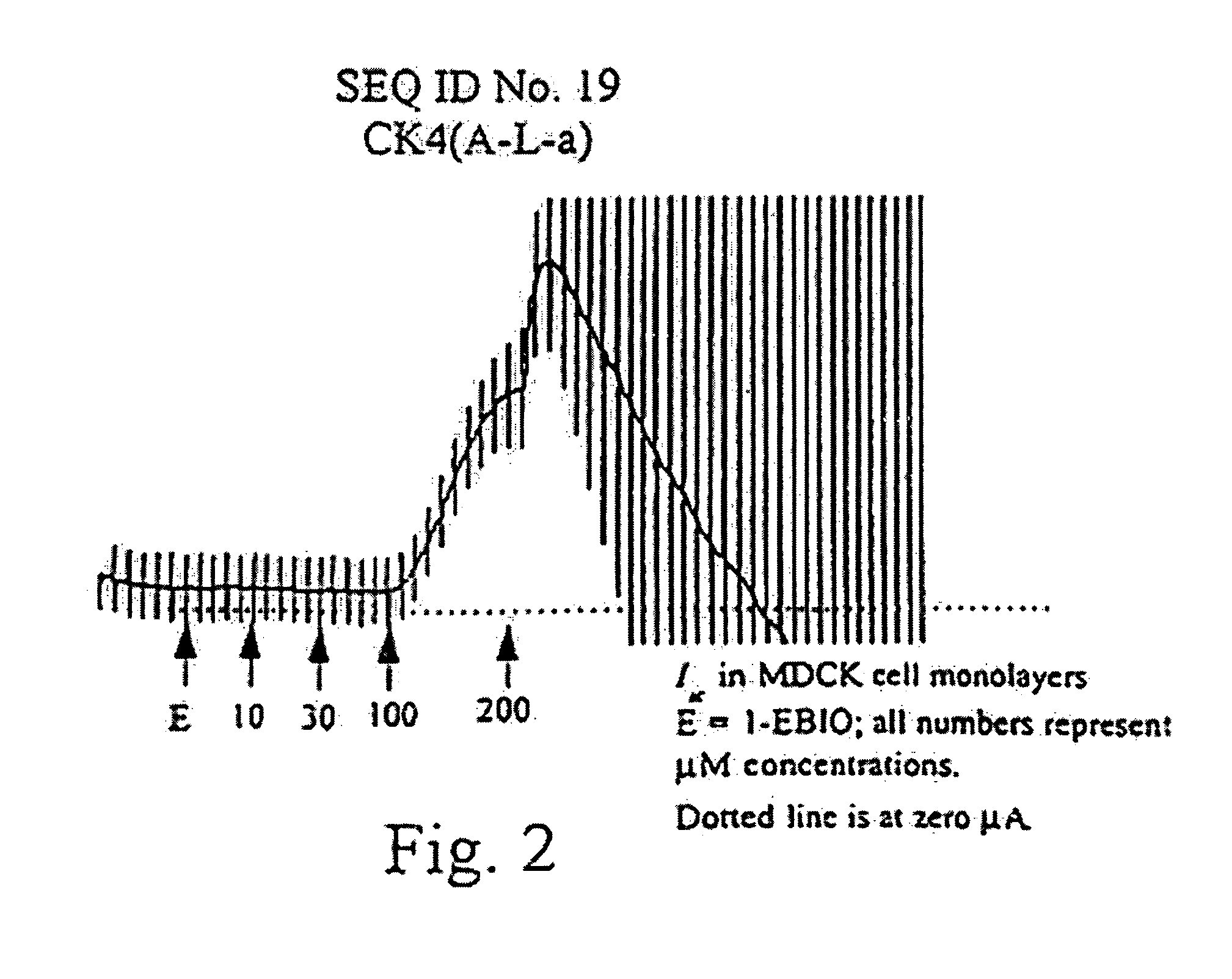Channel forming peptides
a technology of peptides and peptides, applied in the field of multi-peptide channel assemblies, can solve the problems of decreasing bio-availability, and achieve the effects of reducing side effects, high activity, and reducing the amount of side effects
- Summary
- Abstract
- Description
- Claims
- Application Information
AI Technical Summary
Benefits of technology
Problems solved by technology
Method used
Image
Examples
example 1
[0089]This example generated the peptides and cell monolayers for subsequent testing. Additionally, epithelial electrical measurements were taken and activity profiles determined for a number of these generated peptides.
[0090]Materials and Methods
[0091]Peptide synthesis. The synthetic peptides based on the M2GlyR sequence were prepared using an automated solid-phase peptide synthetic technique. The peptides were prepared using the well documented, base-labile, Fmoc-strategy on an Applied Biosystems Model 431A peptide synthesizer (Perkin Elmer, Norwalk Conn.). All solvents were reagent grade unless otherwise indicated and the protected amino acids were purchased from one or more of the following vendors (Perkin Elmer, Norwalk Conn.; Bachem, Torrance Calif.; Peninsula Laboratories, Belmont Calif. and Peptides International, Louisville Ky.). A reaction scale of 0.1 mmol was employed. The resin, p-hydroxymethylphenoxymethyl polystyrene (HMP resin) was purchased with the first amino acid...
example 2
[0109]This example determined the circular dichroism for various peptides generated using the methods of Example 1.
[0110]Materials and Methods
[0111]Circular dichroism: Circular dichroism spectra were recorded on a Jasco Model J-720 spectropolarimeter in the range 180-250 nm using quartz cuvettes with a 0.2 mm pathlength. Eight scans recorded at a rate of 20 nm / minute were averaged and corrected for contributions of buffer (10 mM HEPES, pH 7.2). Peptide concentrations of 50 μM in 20% TFE were used to determine the helical propensity of the different M2GlyR analogs. The molar ellipticity was calculated using d-10-camphorsulfonic acid (290.5=7783° cm2 dmol 1) as a reference (Chen, G. C., and J. T. Yang. 1977. Two point calibration of spectropolarimeter with d-10-camphorsulfonic acid. Anal. Lett. 10:1195-1207.). The line shapes of the spectra were analyzed using a least-square fitting routine by comparison to polylysine standards representing 100%-helix, -turn, or random coil, respectiv...
example 3
[0114]This example determined the emission fluorescence spectra for peptide sequences generated using the methods of Example 1. This example also tested tryptophan containing peptides for their ability to associate with and insert into bilayers.
[0115]Materials and Methods
[0116]Fluorescence: Fluorescence was measured on a Hitachi Model F-4010 steady-state fluorescence spectrometer. All measurements were made in 10×10 mm quartz cuvettes at 37° C. Tryptophan fluorescence was excited at 280 nm with slits set to 5 nm. For samples containing vesicles, the background intensity was scaled appropriately and subtracted from the peptide-containing sample. Potassium iodide quenching measurements were performed by titrating a 4 M solution of KI, prepared daily, into a peptide solution and scanning the intensity of fluorescence from 300-400 nm stimulated by excitation at 280 nm. Stem-Volmer quenching constants KS-V were determined by linear regression with the equation (F0 / F) 1+KS-V [I], where F ...
PUM
 Login to View More
Login to View More Abstract
Description
Claims
Application Information
 Login to View More
Login to View More - R&D
- Intellectual Property
- Life Sciences
- Materials
- Tech Scout
- Unparalleled Data Quality
- Higher Quality Content
- 60% Fewer Hallucinations
Browse by: Latest US Patents, China's latest patents, Technical Efficacy Thesaurus, Application Domain, Technology Topic, Popular Technical Reports.
© 2025 PatSnap. All rights reserved.Legal|Privacy policy|Modern Slavery Act Transparency Statement|Sitemap|About US| Contact US: help@patsnap.com



